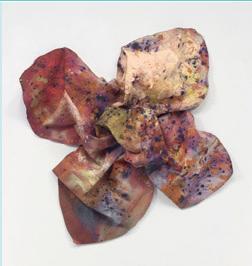Sam Gilliam
dal 10/10/2005 al 22/1/2006
Segnalato da
10/10/2005
Sam Gilliam
Corcoran Gallery Art, Washington
A Retrospective

Curator Jonathan P. Binstock
Sam Gilliam: a retrospective marks the first full-career retrospective of Sam Gilliam and the most extensive presentation of his work to date. Gilliam first achieved widespread acclaim in the late 1960s with his groundbreaking Draped paintings, which blur distinctions between painting, sculpture and architecture. Now into his fifth decade as an artist, Gilliam, who has been described as the most prominent African American abstract painter, continues to create innovative approaches that influence younger generations of artists.
A retrospective reveals the hallmarks of Gilliam’s constantly evolving aesthetic: exploration, risk and formal invention. The exhibition features monumental paintings, elaborate mixed-media constructions and installations.
“Sam Gilliam’s concentrated focus on painting and his belief that, as a discipline made up of objects, it is essentially no different from sculpture radically distinguishes him from his contemporaries who were also interested in furthering the modernist tradition, including color-field painters such as Helen Frankenthaler and the artists associated with the Washington Color School, such as Morris Louis and Kenneth Noland,†notes Jonathan P. Binstock, exhibition organizer and Corcoran Curator of Contemporary Art. “Gilliam’s ambition was, and still is, not just to reinvigorate the modernist tradition, but also to create new possibilities by thinking outside the dominant critical modes through which modernism is generally understood.â€
Featuring approximately 45 works dating from 1967 to the present, a retrospective highlights Gilliam’s early beveled-edge and Draped paintings, his White and Black paintings of the 1970s, metal and wood constructions of the 1980s and 1990s and monochromatic Slatts of recent years. His early Slice paintings are distinguished by the rhythmic patterns of their painted creases, which he made by folding acrylic-soaked canvases like accordions and allowing them to dry before unfurling them to see what he had made. Deep beveled-edge stretchers create the impression that these paintings, with Gilliam’s sybaritic color combinations, are emerging from the wall as objects of weight, substance and sculptural presence.
To create his renowned Draped, or suspended, paintings, Gilliam discarded the stretcher completely, allowing his soaked and stained canvases to sag and hang from gallery ceilings and to interact with sculptural elements, such as handmade sawhorses or site-specific architectural details. Sometimes monumental in scale, these lyrical works swing through space, on occasion enabling viewers to walk under and through them, giving individuals the opportunity to be literally enveloped by painterly color.
In the past, critics have tended either to explain Gilliam’s achievements as a Washington Color School artist or to situate his work within the confines of an African American art tradition. To concentrate too much on either account is to miss the brilliance and scope of his remarkable career, and his significant contributions to abstraction.
“While he is African American, he is not necessarily a maker of black art,†adds Binstock, who wrote his doctoral dissertation on Gilliam and has worked with the artist for many years. “In the late 1960s, Gilliam himself argued adamantly against applying the term ‘black art’ to his work. Indeed, because of its abstract qualities, his work was often criticized at the time for not adhering to the so-called socially responsible aesthetic then popularized by the Black Power movement. Nonetheless, certain works do engage an African American significance, such as Composed (formerly Dark As I Am) (1968 - 74). An extraordinary painting and one of the most important self-portraits of the era, Composed (formerly Dark As I Am) was created as an expressive response to certain kinds of political wrangling that Gilliam believes are out of place in discussions of art.â€
A Washington, D.C. resident, Gilliam has been included in numerous museum and gallery shows and his career was effectively launched in a group show at the Corcoran Gallery of Art in 1969. His first solo museum showcases were in 1968 at The Phillips Collection and in 1971 at the Museum of Modern Art in New York. He was one of six artists to represent the United States at the Venice Biennale in 1972. The Metropolitan Museum of Art, Museum of Modern Art, National Gallery of Art, Art Institute of Chicago, San Francisco Museum of Modern Art, Walker Art Center, Whitney Museum of American Art and the Corcoran Gallery of Art, among other notable institutions, collect his work. Gilliam’s art is also represented in public collections abroad, including the Louisiana Museum, Denmark; Musée d’Art Moderne, Paris; and the Tate Gallery, London.
The Corcoran Gallery of Art
500 17th Street, NW Washington DC 20006
Open Wednesday to Sunday 10am to 5pm
Open Thursday (extended hours) until 9pm
Closed all Mondays except holidays
Closed all Tuesdays & Thanksgiving, Christmas Day, New Year's Day



